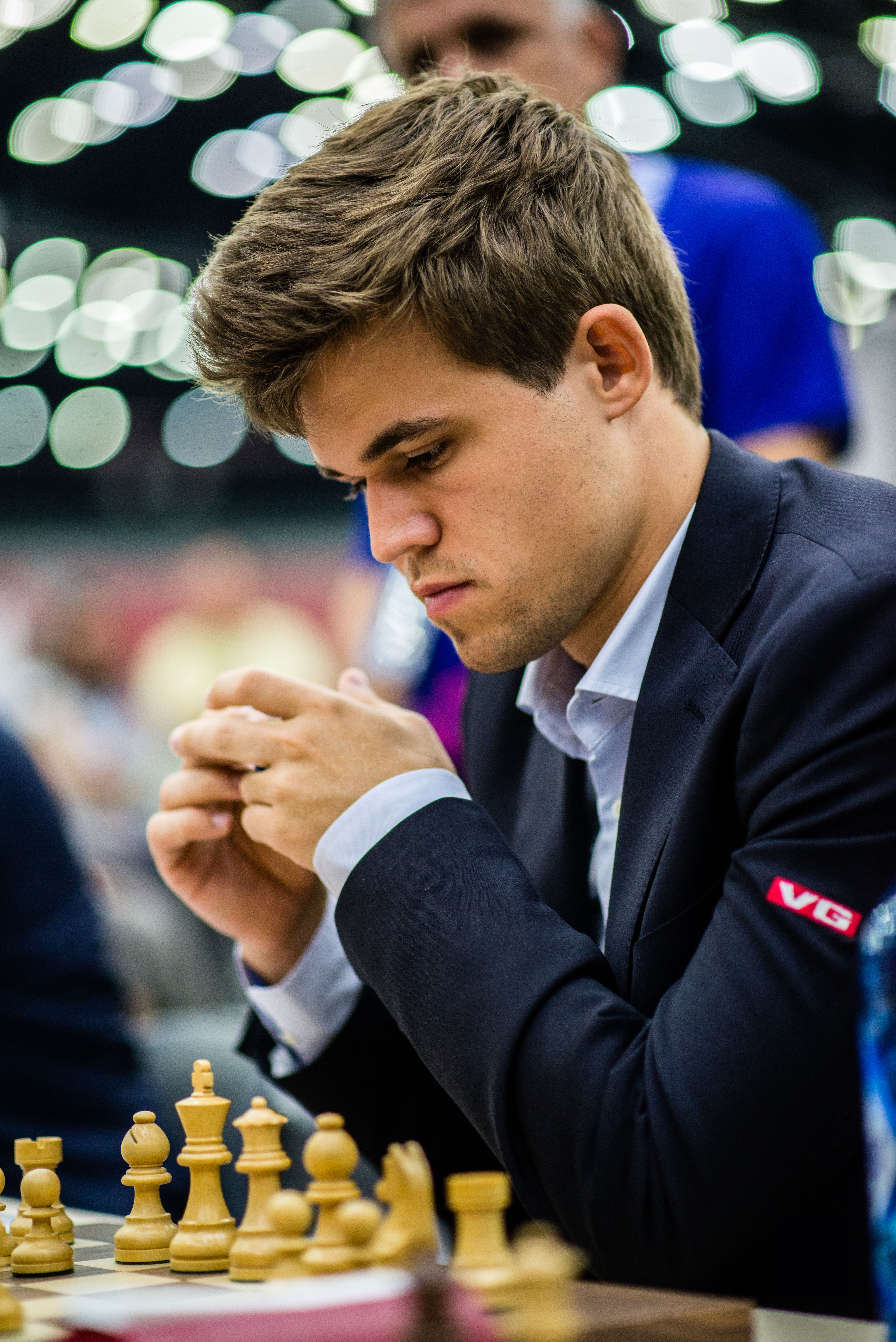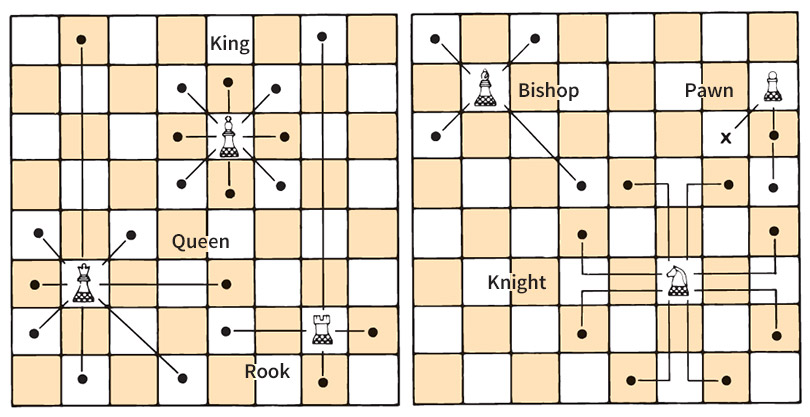Chess is a game of skill in which two players move objects called men on a board divided into squares. Players try to checkmate (trap) the opponent’s principal man, the king, while protecting their own king.
The board and the men.
There is no standard size for chessboards, but most boards fit easily on a table. The chessboard is divided into 64 squares that are arranged in 8 rows of 8 squares each. The squares are alternately light and dark in color. The rows of squares that run across the board are called ranks. The rows that run up and down the board are called files. The slanting rows are called diagonals. Players sit at opposite ends of the board, each with a light-colored square at the right-hand corner.

Each player uses a set of 16 men. One set is light-colored, and the other set is dark-colored. The player who uses the light-colored set is called White. The player with the dark-colored set is Black. Each player’s set includes eight identical men called pawns. The other eight men are called pieces. The pieces consist of one king, one queen, two rooks, two bishops, and two knights.

Before a game begins, players arrange their pieces on the rank nearest them. They also place their pawns on the rank in front of the pieces. The rooks occupy the corner squares. The knights stand next to them, and the bishops stand beside the knights. The queen occupies the central square of its own color, and the king stands next to the queen. The opposing kings and queens face each other across the board.
The moves.
Each chessman moves in a specific way. But players cannot make any move that would expose their king to capture. In addition, each man but the king is assigned a value according to its degree of mobility. In order of value from greatest to least, they are the queen, rook, bishop, knight, and pawn. A man’s value may increase or decrease during a game, depending on its position in relation to the other men.

The queen is the most powerful chessman. It can move in any direction along any rank, file, or diagonal until its path is blocked by another man. The king also moves in any direction, but one square at a time.
A rook can move along any rank or file as far as its path is clear. A bishop can move as far as its path is clear along any diagonal but must stay on the color square it started on. Knights are the only men that can leap over men in their paths. A knight moves in an L shape—one rank up or down and two files left or right, or two ranks up or down and one file left or right. A pawn can advance only one space at a time, except on its first move, when it can advance either one or two squares.
A piece may capture any opposing man that stops its progress. A player makes a capture by moving a man to a space occupied by an enemy man. The player removes the captured man from the board and replaces it on the space with his or her capturing man. A man in danger of being captured is under attack.
A pawn is the only man that does not capture men straight in its path. Instead, it normally captures a man one square to the left or right of the square in front of the pawn. A pawn may also capture en passant (French for “in passing”). This special rule applies only if a player has a pawn on the fifth rank. If an enemy pawn on a neighboring file advances two squares, it can be captured as if it had moved only one square, but it must be captured on the player’s next move. When a pawn reaches the rank farthest from its player, it is promoted (exchanged) for any piece other than a king. Because players usually exchange pawns for queens, this promotion is often called queening the pawn.
How chess is played.
White always moves first in a chess game. The players then alternate moves.
Most chess games are played in three stages—(1) the opening, (2) the middle game, and (3) the end game. In the opening, players move their men to positions where they can attack opposing men or hamper their movements. Experts suggest that players move only one or two center pawns at the beginning of the game and that they bring knights into play before bishops.
Players often castle during the opening to protect the king. This is the only move during which a player can move two men at the same time. To castle, a player moves the king two squares toward either rook, and places the rook on the square the king passed over. A player may castle only if the king or rook have not previously been moved and if no other pieces stand between them. A player cannot castle if the king is under immediate attack (check) or if the square the king crosses or the one it lands on puts it into check.
Much of the excitement in a chess game occurs during the middle game, as players try to gain an advantage in the position of their men in preparation for a direct attack on the enemy king. During the end game, each player concentrates on queening a pawn. Players may use the king as an aggressor during the end game, when most men have been captured and it is safer to bring the king out into the open board.
A player who attacks the enemy king traditionally gives notice by saying “check,” though this is not required. A player whose king is in check must move only to rescue the king. The player may capture the attacking man or move the king to a square that is not under attack. A player can also place a man between the king and the attacking man (interposition). If none of these moves is possible, the game ends in a checkmate. The attacking player wins. A player can resign (surrender) before checkmate if the position appears hopeless.
A chess game may also end in a tie, called a draw. Players may agree to a draw if neither one has an advantage that could lead to a victory. Sometimes, players repeat the same sequence of moves. They declare a draw when they have repeated the sequence three times in a row. Players also draw if each has made 50 consecutive moves without moving a pawn or capturing a man. A kind of draw called a stalemate occurs when a player’s only move would put his or her king in check.
Chess notation.
Most chess players in English-speaking nations use descriptive notation, also called English notation, to keep a written record of their games. In this system, the pieces beside the king are called the kingside, and those beside the queen are called the queenside. Pawns are named for the pieces they stand in front of at the beginning of the game. Players record moves by naming the men and the squares they move to. The squares in each file are named for the piece that occupies the first square in that file at the beginning of the game. For example, the squares in the center files are called the king’s file and the queen’s file. Players number the ranks from one through eight starting from the ranks nearest them.
Letters represent the chess pieces. K stands for King, KB for King’s Bishop, KN for King’s Knight, and KR for King’s Rook. The queen’s pieces are indicated in the same way, using Q for Queen. P stands for Pawn. Other symbols used in descriptive notation include x for captures, — for moves to, and ch for check.
In a system called algebraic notation, the letters a through h indicate the files, beginning from White’s left. The numbers one through eight indicate the ranks, beginning from the rank nearest White. Players record moves of pieces by naming the pieces and the squares they move them to. They record pawn moves by naming only the square the pawn moves to.
History.
Historians do not agree on how old chess is or who invented it. They believe it originated in India in the A.D. 600’s, perhaps earlier, and spread to Persia. Knowledge of the game spread from Persia to nearby countries after the Arabs conquered Persia in the 640’s. Muslim invaders brought chess to Spain in the early 700’s. By 1000, the game had probably spread through Europe as far north as Scandinavia.
The modern era of chess dates from the 1500’s, when the moves of the game began to take their present form. Philidor, a Frenchman who played in the 1700’s, is widely regarded as the first world champion. In 1924, the Fédération Internationale des Échecs (FIDE), also called the World Chess Federation, was founded in Paris. In 1948, FIDE became responsible for organizing the world chess championship. From 1948 to 1972, every world chess champion was from the Soviet Union. In 1972, Bobby Fischer became the first American to win the official world chess championship. FIDE took away Fischer’s title in 1975 after he refused to play challenger Anatoly Karpov of the Soviet Union under federation rules. Karpov therefore became the world champion by default.
FIDE took the world championship title away from Garry Kasparov of Russia in 1993 and away from Anatoly Karpov of Russia in 1999 after the two champions refused to play in a FIDE tournament for the title. Both players criticized FIDE’s handling of the world championship. Kasparov created the Professional Chess Association (PCA) in 1993 and held the PCA title until it dissolved in 1998. Brain Games Network, a British Internet company, sponsored a non-FIDE title match in 2000 in which Vladimir Kramnik of Russia defeated Kasparov. The company went out of business, and an agreement was made in 2002 to unify the championship. However, matches to determine an undisputed champion did not take place until 2006. In that year, Kramnik won a unified world title by defeating the FIDE champion, Bulgarian Veselin Topalov. From that point, winners of the FIDE title were undisputed world champions.
See also Anand, Viswanathan ; Carlsen, Magnus ; Fischer, Bobby ; Kasparov, Garry .
